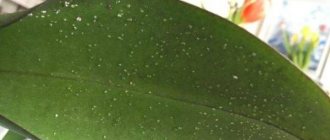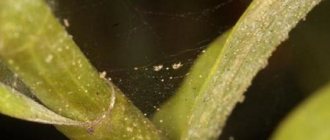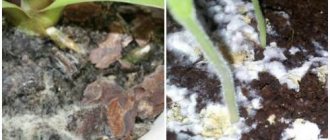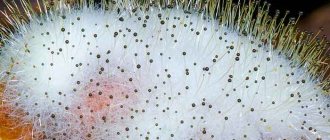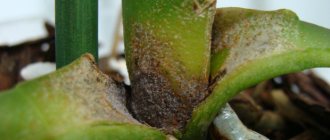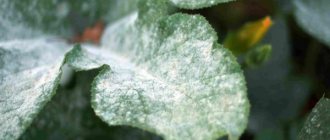There are many types of flowers. However, one of the most beautiful is, of course, the orchid. The orchid itself is an unpretentious flower and adapts to different conditions.
If stored and cared for improperly, this beautiful flower can develop such an unpleasant thing as mold.
Why white and black mold appears in the pot, on the leaves and roots and how to treat the plant - let’s figure it out together. You will also see what this disease looks like on the plant.
How to get rid of it?
Let us consider in more detail what to do in this situation, how to combat the formation of this disease on various parts of the flower.
On the leaves
There are two types - white and black.
If white mold appears on the surface and in the axils of the leaves, this is the initial stage of the disease. You can fight it with a solution of copper sulfate. To do this, take a teaspoon of vitriol and dilute it in 2 liters of water. The solution should be a pale blue color . They should wipe the leaves, especially carefully in places where mold accumulates the most. Or spray 2 times a day until the plaque disappears.
If black mold has already appeared on the flower, then it is better to carefully trim the affected leaves and wipe the cut areas with the same vitriol solution.
On the roots
This type of fungus is more difficult to fight.
- First of all, it is necessary to completely dry the substrate in which the orchid grows.
- Then it is recommended to thoroughly loosen the soil, remove the flower itself from the pot and thoroughly rinse the damaged areas (recommended water temperature 35 degrees); if dried roots are found, it is better to carefully trim them.
- Place the treated flower (stems and roots) in the fungicide solution for 15 minutes.
In the substrate
Moldy soil is best disposed of . Before planting the orchid in a new substrate, you need to soak it (soil) in boiling water for about 15 minutes. After this, wait until it dries completely and only then fill the container where you place the orchid.
It is recommended to put 3 crushed tablets of activated carbon or wood bark into the substrate. After planting, it is not recommended to water the orchid for about 3-5 days. This is done to ensure that the damaged areas heal and new problem areas do not form. It is also advisable to place the orchid in a well-lit, dry place.
Below you can watch a video that tells you what to do with mold on an orchid:
If the entire plant is affected
If the flower is completely covered with mold, then you can try to carefully cut off the mold with a sharp knife , then treat the damaged areas with a solution of copper sulfate (how to prepare it is indicated above).
It is also recommended to transplant the flower into another pot with a new substrate, previously disinfected. After this, do not water the flower for 5 days and keep it in conditions with minimal air humidity, preferably in direct sunlight. Even in this case, you can use ultraviolet lamps and warm the orchid with them.
Types of mold that are dangerous for orchids
At first glance, the white fluffy coating appears to look the same. Actually this is not true. Various pathogens settle on the substrate, roots and leaves. Control measures and the choice of medicinal drugs depend on what the plant is infected with.
Read more about the characteristics of mold.
White mold in the substrate
How to deal with it
A nutrient mixture for orchids is essentially plant residues - pine bark, sphagnum moss, fern roots, coconut chips, etc. With strong moisture, it becomes an excellent breeding ground for microorganisms, including those harmful to plants. To avoid plant infection, it is better to buy soil mixture for orchids from trusted manufacturers. But even then, it is worth treating the substrate before planting the plants. Moreover, this is not difficult to do if you follow these recommendations:
| Step 1 | Place the required amount of the purchased mixture in a metal container so that it fits freely, without compaction. |
| Step 2 | Pour boiling water over and leave until completely cool to room temperature. |
| Step 3 | Then, drain the water and let the excess moisture drain away. |
| Step 4 | Plant an orchid whose root system has been pre-treated with fungicides. |
Important! The substrate that you prepared yourself must be subjected to heat treatment. After all, bark and moss brought from a forest or park necessarily contain microorganisms, including pathogens.
If there is little mold on the surface of the substrate, then you can get rid of it by removing it with part of the soil . The mixture remaining in the pot must be completely dried. And during further watering, make sure that the water does not stagnate, and that the substrate dries out from top to bottom in between irrigations.
On average, once every 2-3 years, the soil mixture for orchids must be replaced with a fresh composition. Don't wait for mold to appear. It is better to replant the orchid on time.
This is also done when a white coating is found on the roots.
The substrate on which mold has appeared must be replaced.
Mold on the roots is a serious threat to the health of the orchid.
Pathogens that settle on the roots destroy spongy tissue - velamen.
Velamen is a complex integumentary membrane that performs a respiratory function and supplies the orchid with nutrients obtained from the air.
A. S. Karavaeva
“Beautiful and mysterious orchid,” World of Orchids magazine, No. 3, 2009.
Mold on the roots can cause the orchid to die.
The fungus grows into the roots, damaging them at the cellular level. They cannot function normally and the plant becomes weakened. If mold is not eliminated, it can completely take over the root system and destroy it.
How to protect roots from mold
To save an orchid from mold, it needs to be transplanted into a fresh, disinfected substrate.
- To do this, the plants are removed from the pot and cleaned of old soil.
- The roots are washed under a light stream of warm water to better examine possible damage.
- If the roots are too damaged, they are cut off. Sections are made 3 cm above the affected area
Tip #2 . Cutting instruments must be disinfected in advance so as not to transfer mold to open wounds.
- After pruning, the root system is soaked in a fungicide solution.
A proven anti-mold remedy is copper sulfate. It is sold in garden stores.
Copper sulfate is a fine crystalline powder of bright blue color.
Copper sulfate is widely used to protect garden plants from fungal pathogens. The drug is also effective against mold on orchids.
When the affected roots are cut off, they are soaked in a solution prepared:
- from two grams of copper sulfate and one liter of water.
Tip #3 . Before using the liquid, you need to wait until the crystals are completely dissolved. To ensure that the roots are protected from burns that can be caused by microparticles, it is better to filter the solution through a double layer of gauze.
- Place the roots in a solution of copper sulfate for 15 minutes.
- Dry before planting in fresh substrate. To disinfect the soil mixture, several tablets of activated carbon are placed in it.
After transplantation, the orchid is quarantined for 2-3 weeks. If mold does not appear during this time, the plant is returned to its permanent place.
With further care for prevention, from time to time, potassium permanganate (potassium permanganate) is added to the water for irrigation . The solution is made pale pink and filtered before irrigation.
Another way is to use citric acid , mold does not like an acidic environment:
- ½ teaspoon food grade citric acid.
- 200 ml of warm water +300, preferably boiled.
The orchid is watered with this solution twice a month.
Some gardeners place dry lemon or orange peels around pots of orchids. Peels from other citrus fruits will also work. The evaporated aroma suppresses the spread of mold spores.
How not to treat a flower?
- Under no circumstances should high humidity be allowed in the room where the flower is located.
- Don't overdo the chemicals used to combat mold.
- Although drying and a sunny place for treating the flower are recommended, one should not forget that prolonged exposure to direct sunlight (especially in the hot summer period) can lead to thermal burn of a delicate orchid.
- If you use a solution of copper sulfate or fungicide, then you should not allow a high concentration of these chemicals, as this can cause a chemical burn to the flower.
Prevention
To do this, you need to make drainage holes in the pot where the flower grows. The substrate in which the orchid is located must be dried occasionally, that is, do not water it for several days. It is best to use clean filtered water for irrigation.
Occasionally add a weak solution of potassium permanganate to the water for irrigation (the color should be soft pink, not brighter). Sometimes you can add a couple of tablets of activated carbon or tree bark to the orchid substrate. Maintain temperature conditions. The optimal temperature is 22-25 degrees. Avoid high humidity and it is best to place the flower in a sunny place.
Post-treatment care
An orchid that has suffered a fungal disease is best placed for a while away from other plants. It is advisable that it be a dry, warm, well-ventilated room. Provide the flower with access to the sun. Also, after treatment and removal of mold, it is best not to water the flower for several days; it is necessary to periodically loosen the soil in which the orchid grows.
The renewed substrate can be treated with a solution of foundationazole (two grams per liter of water). Twice a month it is recommended to dilute 0.5 teaspoon of citric acid in a glass of water and water the plant with this solution. Some gardeners recommend dropping a few cloves of garlic into the orchid pot after watering. You need to keep them there until the soil dries completely after watering and then remove them.
You can also use dried citrus peels . Place them around the flower for a couple of days.
So, we have figured out why the roots and other parts of the orchid become moldy and what to do about it. The most important thing is not to panic when you notice signs of this disease, but to provide timely assistance to the flower. Regularly inspect the flower for symptoms of mold and follow simple rules for caring for the plant. Periodically carry out preventative maintenance on your orchid and then it will delight you with its color for a long time.
If you find an error, please select a piece of text and press Ctrl+Enter.
What is it and what does it look like?
Mold is a fungus that often affects indoor plants; it looks like a shaggy coating that forms on the leaves, stems and roots. It spreads and reproduces with the help of spores, which are extremely tenacious. Once brought into the house, fungal spores can infect the entire flower if not properly cared for.
You can learn more about what mold is, why it appears on an orchid and how to get rid of it in this article.
What can cause white blossoms?
The main factor for the active spread of fungus on an orchid is too high air humidity and too intensive spraying. For some types of orchids, such as phalaenopsis, foliar irrigation is completely contraindicated. For many other species, spraying is indicated only for the root system.- The second factor is very intensive watering . If there are not only signs of a flower being damaged by a fungus, but also rotting of the roots or the stems themselves, then it is necessary to limit the amount of watering (we talked more about whether it is possible to save an orchid from rot and what are the reasons for its appearance here).
It is necessary to water the orchid only when the entire substrate is dry. Watering is done by immersing the pot in water for about 30 minutes.
- The third factor is too cold or too hard water . It is advisable to water the orchid with bottled or rain water, allowing it to settle first. The water should be at room temperature.
- The fourth factor is stagnation of moisture in the core or axils of the leaves . To avoid this, after spraying and watering, be sure to remove water from the axils of the leaves or from the core of the rosette.
- The fifth factor is where the flower lives is too high If the heat is combined with high humidity, the fungus on the orchid will not take long to appear.
- The sixth factor is dead leaves and flowers not removed in time . From them, the fungus can first infect the soil, and then the entire plant.
How to get rid of fungus?
In the leaf axils
There are two types of mold on orchid leaves - white and black. White mold is easier to deal with. You need to dilute a teaspoon of vitriol in 2 liters of water and wipe the leaves with the resulting solution. Activated carbon works well against fungus - you can crush the tablet and powder the leaves in the affected areas.
Black mold is practically untreatable , so diseased leaves are cut off, disposed of, and the cut areas are wiped with a solution of vitriol.
On the roots
It is worse if the fungus affects not only the leaves, but also the orchid root, since mold destroys its shell, extremely weakening the plant.
- The orchid must be removed from the substrate, the root must be washed very thoroughly, paying special attention to the affected areas, in warm water (at a temperature of 30-35 degrees).
- Soak the roots and stem of the plant for 15 minutes in a very weak solution of fungicide (for example, 1/4 or 1/6 of the concentration indicated on the package).
Why does a plant become moldy?
White mold appears on flowers as a result of overwatering combined with high room temperatures. The most dangerous time of year is hot summer, when you want to save your favorite flowers from the heat by introducing additional watering. We do not recommend spraying the orchid, as moisture on the leaves leads to the development of fungus.
But mold can also appear if you buy a flower already infected with spores. Fungal colonies are dormant in the substrate, on leaves, flowers, and stems.
How to fight white mold on the leaves of indoor plants? Flower shops offer a variety of remedies for mold deposits on soil and indoor flowers. In this case, the products are divided depending on the type of fungal infection (white or black mold) and are selected for different plants, for example, flowering plants, palm trees, cacti, and so on.
Mold
On orchids
The familiar mold becomes a frequent enemy of orchid lovers. It can be seen on rotting fruits, damp walls, and, even worse, on your favorite plant. It consists of many types of fungi that can spread extremely quickly using microscopic spores.
Mold spreads very quickly.
Most common types
- White mold . In appearance it looks like fluffy lumps of medical cotton wool;
- Blue mold . Settles in islands, fluffy.
This fungal disease can affect all plant organs and even the substrate. So you can find mold on flowers, leaves, stems and bark.
Reasons for appearance
Mold appears on orchids just like on any other object. The fluffy coating spreads over everything that is accessible to it. Spores necessary for reproduction may be present in the substrate or in the air. The most optimal conditions for this are humidity and warmth.
Mold is easy to see with the naked eye. A clear sign that will help distinguish one species from another is color.
Most often, troubles with plants occur as a result of improper care . It is known that mold requires moisture and heat to spread. Such conditions are fundamental for the development of almost everything:
Mold itself does not harm the plant. She is a saprophyte, which means that she feeds on decaying organic matter, that is, she will not touch a healthy plant. In this case, she can warn that rotting and other diseases that will be much more difficult to treat are so close.
What is it, what does it look like and where is it formed?
Mold is a variety of fungi that can spread through the air very quickly using microscopic spores.
You can tell that your favorite plant is infected with mold by the thick fluff on the surface of the leaves, roots or substrate. The color depends on what pathogen has settled on the flower and can vary from light gray to greenish. On orchids you can most often find white and black mold.
This fungal disease can affect any plant organ and even the substrate. Therefore, you can see it at:
- leaves;
- bark;
- stems;
- and even on flowers.
Defeat
Leaves
The leaf blade is most often affected by white mold. If white mold is found on orchids - what to do?
- First, you need to arrange watering . Since such a disease has already appeared, then excess moisture is clearly present.
- In addition, you should pay attention to spraying , perhaps it is too frequent.
- It is possible that the air in the room is simply too humid, which harms not only plants, but also human health. In this case, it is necessary to regularly ventilate the room or even resort to using a special dehumidifier.
In order to remove some of the spores and the fungi themselves, it is recommended to treat the leaves with a solution of copper sulfate.
Copper sulfate solution: dissolve 1 teaspoon of copper sulfate in two liters of settled water. Wipe the leaves with a cotton swab or spray, but not often, otherwise it will still be damp.
Particular attention should be paid to the axils of the leaves and avoid stagnation of water in them.
Roots
It is much more serious if the mold spreads to the root system. If this happens, then you need to immediately carefully remove the plant from the pot to assess the scale of the problem. The roots are washed under running water, the temperature of which is +35 degrees, and soaked in a fungicide solution , in a ratio of 1 to 6, for 15 minutes.
If rot or soft areas are found on the roots, it is necessary to remove these fragments using a sharp, disinfected blade, and treat the cut areas with crushed activated carbon or cinnamon.
Rotten roots must be cut off.
In order to prevent mold from appearing again, it is better to change the substrate , as there may be spores in it, and also wash the pot. Old bark should be boiled for a few minutes so that it can be safely used in the future.
Peduncles and buds
If the plant is already affected by white mold and has flowered, and the old buds and flower stalks have not been removed, then the fungal disease can begin to spread from them. In this case , you just need to promptly remove dead parts of the plant so as not to provoke the appearance of mold.
Whole plant
You can see mold on a healthy peduncle only if the entire plant has already been captured. Since it has already spread throughout the entire orchid, there is a very high risk that some part is rotting. First you need to pull out the orchid to inspect it, remove excess, then rinse with fungicide. The substrate must be replaced with a new one.
In case of severe rot it is better to remove the flower stalks , since the orchid is now in a painful and weakened state, and flowering requires a lot of effort. After the plant is returned to the washed pot, you should again think about the correct maintenance and understand the reasons for such a rapid spread of the fungus.
What does white plaque look like on an orchid?
A white sticky coating can affect a flower in two cases: the plant has contracted an infection or it has been attacked by pests. Both the first and second are extremely dangerous for the orchid: they can quickly kill it. Treating such ailments is also quite difficult.
For your information! If the orchid has been attacked by parasites, then you should notice a white coating formed on the leaves (less often the stems), similar to cotton fibers or flakes. This means that the plant has been sick for quite some time, since the first signs of pest damage are the formation of sticky drops on the surface of the leaves.
If the plant becomes infected, the symptoms are somewhat different. Usually, when fungal infections occur, the lower surfaces of the leaf blades are the first to suffer. They become covered with a powdery coating, which grows as fungal spores develop. The danger is that the fungus grows very quickly, which means that the lack of timely treatment will lead to rotting of the orchid.
White plaque may appear in the following areas of the plant:
- on sheet plates;
- stems;
- root system.
On the leaves
Often, diseases and infections affect orchid leaves. Over time (and without proper treatment), the problem can spread to the stems, but rarely do problems start there.
Usually those flowers that do not receive proper care are at risk. Their immune system weakens and opens the way to all possible infections, among which white plaque is the most common. Lack of proper care leads to a failure of the orchid's metabolic processes, and this in turn affects the composition of the plant juice. It is because of this that various diseases and pests perceive orchids as easy prey.
Depending on the causes of the lesion, the disease may look different. Most often, the main signs of problems are:
- drying of orchid leaves and stems;
- premature completion of flowering (poor flowering);
- the inflorescences quickly fade and fall without even opening;
- Sticky drops appear on the leaves;
- Over time, the sticky drops turn into a white coating.
Important! If the plant has been affected by pests, then plaque appears on the front side of the leaf plates in the form of flakes or cotton fibers. If a plant is affected by a fungal infection, the disease will appear on the underside of the leaves and will look like a powdery coating that quickly grows over the surface of the leaf and stem.
On the stems
White bloom rarely appears on orchid stems. Most often, it moves there in the later stages of disease development from the leaf blades. It usually looks like this:
- sticky drops of sweet secretion;
- white powdery coating with the texture of cotton fibers;
- gray-green mold.
On the roots
Orchid roots in most cases are subject to infectious attack. This part of the plant is difficult for pests to access, so they prefer something simpler, such as leaves.
The main problem that orchid owners may encounter is mold. This fungal infection looks like a fibrous coating that can appear on all parts of the plant (except inflorescences). Mold reproduces with the help of spores, so the disease spreads quickly, affecting all healthy areas in a short time. If a fungus was brought into the house, expect complete infection of the plants.
The color of mold can vary:
- light gray (this variety is called white);
- green;
- black.
Outwardly, it looks like a shaggy crust that covers the roots of the plant. This disease is also dangerous because it can hibernate for a long time somewhere in the roots of the orchid. As soon as the external environment allows, the fungus immediately wakes up and begins its active activity.
Important! Mold can infect all parts of the plant as it spreads through the voids between the bark of roots and stems and along the surface of the soil.


